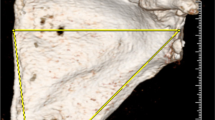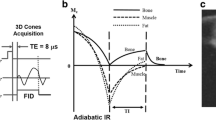Abstract
Objective
To determine whether 3D-MR osseous reformats of the shoulder are equivalent to 3D-CT osseous reformats in patients with glenohumeral instability.
Materials and methods
Patients with glenohumeral instability, who were to be imaged with both CT and MRI, were prospectively selected. CT and MR were performed within 24 h of one another on 12 shoulders. Each MR study included an axial 3D isotropic VIBE sequence. The image data from the isotropic VIBE sequence were post-processed using subtraction and 3D software. CT data were post-processed using 3D software. The following measurements were obtained for both 3D-CT and 3D-MR post-processed images: height and width of the humeral head and glenoid, Hill-Sachs size and percent humeral head loss (if present), size of glenoid bone loss and percent glenoid bone loss (if present). Paired t-tests and two one-sided tests for equivalence were used to assess the differences between imaging modalities and equivalence.
Results
The measurement differences from the 3D-CT and 3D-MR post-processed images were not statistically significant. The measurement differences for humeral height, glenoid height and glenoid width were borderline statistically significant; however, using any adjustment for multiple comparisons, this failed to be significant. Using an equivalence margin of 1 mm for measurements and 1.5% for percent bone loss, the 3D-MR and 3D-CT post-processed images were equivalent.
Conclusion
Three-dimensional-MR osseous models of the shoulder using a 3D isotropic VIBE sequence were equivalent to 3D-CT osseous models, and the differences between modalities were not statistically significant.







Similar content being viewed by others
References
Bishop JY, Jones GL, Rerko MA, et al. 3-D CT is the most reliable imaging modality when quantifying glenoid bone loss. Clin Orthop Relat Res. 2013;471:1251–6.
Rerko MA, Pan X, Donaldson C, et al. Comparison of various imaging techniques to quantify glenoid bone loss in shoulder instability. J Shoulder Elb Surg. 2013;22:528–38.
Gyftopoulos S, Yemin A, Mulholland T, et al. 3DMR reconstructions of the shoulder using a gradient-echo based two-point Dixon reconstruction: a feasibility study. Skelet Radiol. 2013;42:347–52.
Gyftopoulos S, Beltran LS, Yemin A, et al. Use of 3D MR reconstructions in the evaluation of glenoid bone loss: a clinical study. Skelet Radiol. 2014;43:213–8.
Kwon YW, Powell KA, Yum JK, Brems JJ, Iannotti JP. Use of three-dimensional computed tomography for the analysis of the glenoid anatomy. J Shoulder Elb Surg. 2005;14:85–90.
Bokor DJ, O’Sullivan MD, Hazan GJ. Variability of measurement of glenoid version on computed tomography scan. J Shoulder Elb Surg. 1999;8:595–8.
Gyftopoulos S, Hasan S, Bencardiono J, et al. Diagnostic accuracy of MRI in the measurement of glenoid bone loss. AJR. 2012;199:873–8.
Provencher MT, Bhatia S, Ghodadra NS, et al. Recurrent shoulder instability: current concepts for evaluation and management of glenoid bone loss. J Bone Joint Surg Am. 2010;92 Suppl 2:133–51.
Walker E, Nowacki AS. Understanding equivalence and noninferiority testing. J Gen Intern Med. 2011;26(2):192–6.
Burkhart SS, Danaceau SM. Articular arc length mismatch as a cause of failed Bankart repair. Arthroscopy. 2000;16:740–4.
Chen AL, Hunt SA, Hawkins RJ, Zuckerman JD. Management of bone loss associated with recurrent anterior glenohumeral instability. Am J Sports Med. 2005;33:912–25.
Piasecki DP, Verma NN, Romeo AA, Levine WN, Bach Jr BR, Provencher MT. Glenoid bone deficiency in recurrent anterior shoulder instability: diagnosis and management. J Am Acad Orthop Surg. 2009;17:482–93.
Latarjet M. Treatment of recurrent dislocation of the shoulder [in French]. Lyon Chir. 1954;49:994–7.
Helfet AJ. Coracoid transplantation for recurring dislocation of the shoulder. J Bone Joint Surg (Br). 1958;40:198–202.
Warner JJ, Gill TJ, O’Hollerhan JD, Pathare N, Millett PJ. Anatomical glenoid reconstruction for recurrent anterior glenohumeral instability with glenoid deficiency using an autogenous tricortical iliac crest bone graft. Am J Sports Med. 2006;34:205–12.
Provencher MT, Ghodadra N, LeClere L, Solomon DR, Romeo AA. Anatomic osteochondral glenoid reconstruction for recurrent glenohumeral instability with glenoid deficiency using a distal tibia allograft. Arthroscopy. 2009;25:446–52.
Taylor D, Arciero R. Pathologic changes associated with shoulder dislocations. Am J Sports Med. 1997;25:306–11.
Miniaci A, Berlet G. Recurrent anterior instability following failed surgical repair: allograft reconstruction of large humeral head defects. J Bone Joint Surg (Br). 2001;83:19–20.
Wolf EM, Pollack M, Smalley C. Hill-Sachs “remplissage”: an arthroscopic solution for the engaging Hill-Sachs lesion. Arthroscopy. 2007;38:302–7.
Gyftopoulos S, Albert M, Recht MP. Osseous injuries associated with anterior shoulder instability: what the radiologist should know. AJR. 2013;202:W541–50.
Rowe CR, Zarins B, Ciullo JV. Recurrent anterior dislocation of the shoulder after surgical repair: apparent causes of failure and treatment. J Bone Joint Surg Am. 1984;66:159–68.
Bühler M, Gerber C. Shoulder instability related to epileptic seizures. J Shoulder Elb Surg. 2002;11:339–44.
Miniaci A, Berlet G, Hand C, Lin A. Segmental humeral head allografts for recurrent anterior instability of the shoulder with large Hill-Sachs defects; a two to eight year follow up. J Bone Joint Surg (Br). 2008;90 suppl 1:86.
Bock P, Kluger R, Hintermann B. Anatomical reconstruction for reverse Hill-Sachs lesions after posterior locked shoulder dislocation fracture: a case series of six patients. Arch Orthop Trauma Surg. 2007;127:543–8.
Gerber C, Lambert SM. Allograft reconstruction of segmental defects of the humeral head for the treatment of chronic locked posterior dislocation of the shoulder. J Bone Joint Surg Am. 1996;78:376–82.
Miniaci A, Gish MW. Management of anterior glenohumeral instability associated with large Hill-Sachs defects. Tech Should Elbow Surg. 2004;5:170–5.
Sekiya JK, Wickwire AC, Stehle JH, Debski RE. Hill-Sachs defects and repair using osteoarticular allograft transplantation biomechanical analysis using a joint compression model. Am J Sports Med. 2009;37:2459–66.
Sugaya H, Moriishi J, Dohi M, et al. Glenoid rim morphology in recurrent anterior glenohumeral instability. J Bone Joint Surg Am. 2003;85-A:878–84.
Taylor DC, Arciero RA. Pathologic changes associated with shoulder dislocations: arthroscopic and physical examination findings in first time, traumatic anterior dislocations. Am J Sports Med. 1997;25:306–11.
Griffith JF, Antonio GE, Tong CW, Ming CK. Anterior shoulder dislocation: quantification of glenoid bone loss with CT. AJR. 2003;180:1423–30.
Burkhart SS, De Beer JF. Traumatic glenohumeral bone defects and their relationship to failure of arthroscopic Bankart repairs: significance of the inverted-pear glenoid and the humeral engaging Hill-Sachs lesion. Arthroscopy. 2000;16:677–94.
Boileau P, Villalbe M, Hery JY, Balg F, Ahrens P, Neyton L. Risk factors for recurrence of shoulder instability after arthroscopic Bankart repair. J Bone Joint Surg Am. 2006;88:1755–63.
Itoi E, Lee SB, Berglund LJ, Berge LL, An KN. The effect of a glenoid defect on anterioinferior stability of the shoulder after Bankart repair: a cadaveric study. J Bone Joint Surg Am. 2000;82:35–46.
Lo IK, Perten PM, Burkhart SS. The inverted pear glenoid: an indicator of significant glenoid bone loss. Arthroscopy. 2004;20:169–74.
Greis PE, Scuderi MG, Mohr A, Bachus KN, Burks RT. Glenohumeral articular contact areas and pressures following labral and osseous injury to the anteroinferior quadrant of the glenoid. J Shoulder Elb Surg. 2002;11:442–51.
Lynch JR, Clinton JM, Dewing CB, Warme WJ, Matsen 3rd FA. Treatment of osseous defects associated with anterior shoulder instability. J Shoulder Elb Surg. 2009;18:317–28.
Beran MC, Donaldson CT, Bishop JY. Treatment of chronic glenoid defects in the setting of recurrent anterior shoulder instability: a systematic review. J Shoulder Elb Surg. 2010;19:769–80.
Bigliani LU, Newton PM, Steinmann SP, Connor PM, McIlveen SJ. Glenoid rim lesions associated with recurrent anterior dislocation of the shoulder. Am J Sports Med. 1998;26:41–5.
Flatow EL, Warner JI. Instability of the shoulder: complex problems and failed repairs: Part I. Relevant biomechanics, multidirectional instability, and severe glenoid loss. Instr Course Lect. 1998;47:97–112.
Ochoa Jr E, Burkhart SS. Glenohumeral bone defects in the treatment of anterior shoulder instability. Instr Course Lect. 2009;58:323–36.
Yamamoto N, Itoi E, Abe H, Kikuchi K, Seki N, Minagawa H, et al. Effect of an anterior glenoid defect on anterior shoulder stability: a cadaveric study. Am J Sports Med. 2009;37:949–54.
Author information
Authors and Affiliations
Corresponding author
Ethics declarations
Conflict of interest
The authors declare that they have no conflict of interest.
Rights and permissions
About this article
Cite this article
Stillwater, L., Koenig, J., Maycher, B. et al. 3D-MR vs. 3D-CT of the shoulder in patients with glenohumeral instability. Skeletal Radiol 46, 325–331 (2017). https://doi.org/10.1007/s00256-016-2559-4
Received:
Revised:
Accepted:
Published:
Issue Date:
DOI: https://doi.org/10.1007/s00256-016-2559-4




